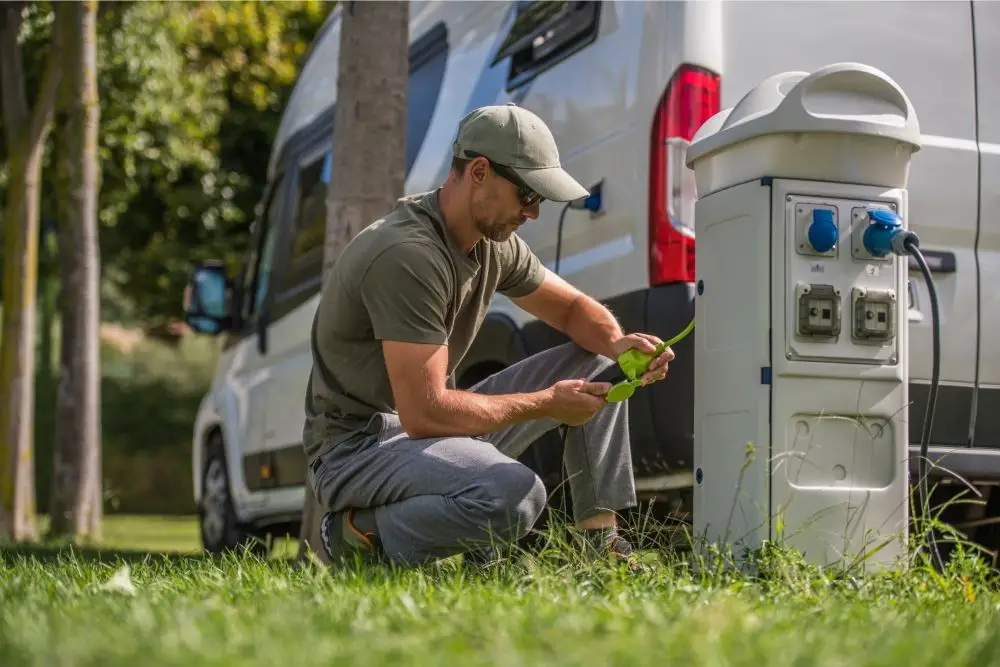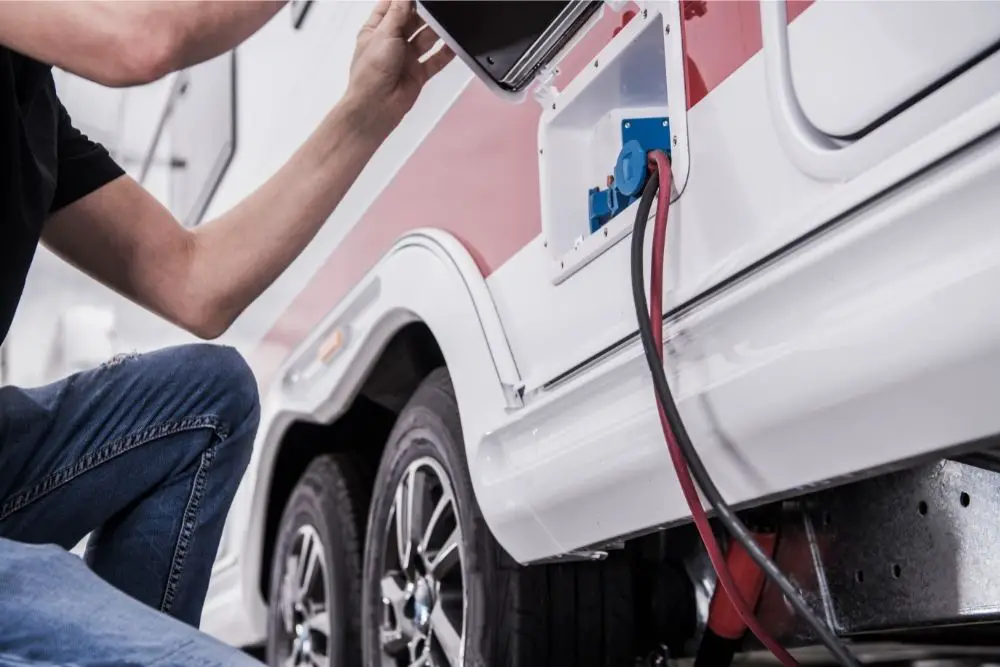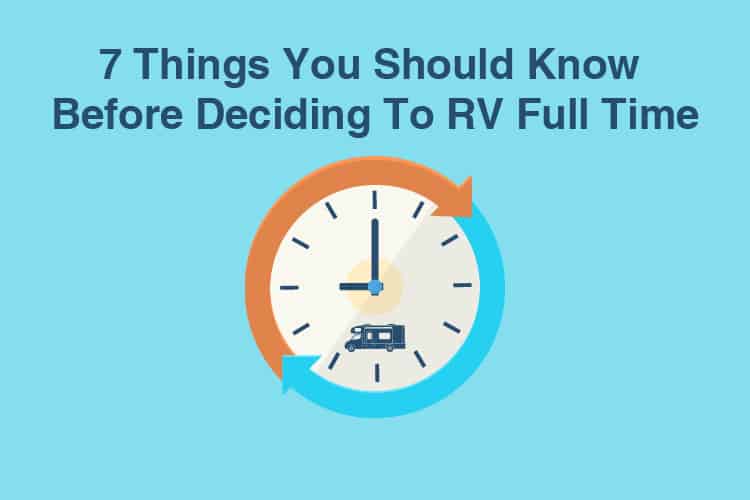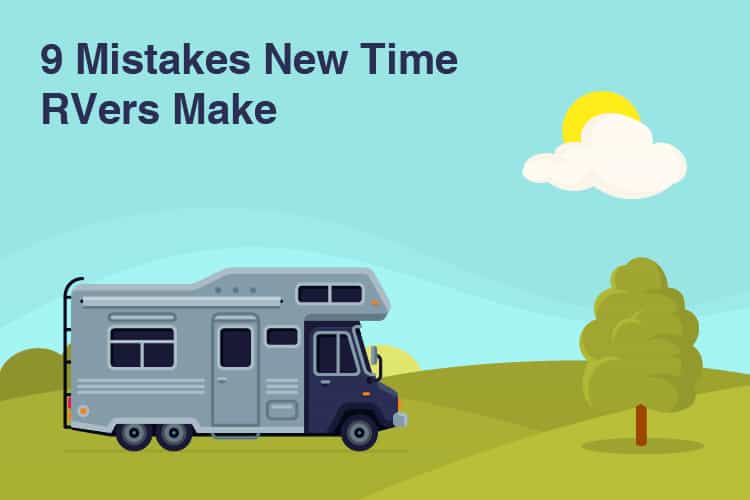There’s nothing like planning a trip, loading your bags into your RV, and hitting the road. Sometimes the planning can be half the fun, deciding which towns to explore, what coastlines to hug. But the least part fun is figuring out how you will power your RV, and unfortunately, it’s part of the trip you have to plan.

After all, it’s no use rocking up to an RV campsite and realizing you can’t connect to the power! How will you recharge and keep your appliances running? Often, we find ourselves wondering about adapters and if we can use different power to charge our RVs, especially if we find ourselves having to stay at a campsite at the last minute.
So we find ourselves asking, can I safely plug my 30 amp RV into 50 amp of power? Do I need an adapter? These questions can haunt us and keep us up at night, interrupting our sleep and leaving us with bags under our eyes.
Well, no more! Today, we are here to answer your questions and find out how you can charge your 30 amp RV at a 50 amp campsite!
Can you safely plug a 30 amp RV into a 50 amp shore power?
Before you go any further, let’s get this question answered for you! After all, not everyone has the time to enjoy an entire article, do they? The answer is, yes, you can safely plug your 30 amp RV into a 50 amp socket! Gone are the days of facing a night without power, plug in and enjoy power!
But with all things in life, it isn’t that easy. You will need an adapter to ensure the power flows from the campsite to your RV safely. The adapter you need will be a 120V 50 amp male plug on the male end and a 120V 30 amp female socket to allow for a safe transfer of power.
Using these adaptors is pretty simple. To start, take the 30 amp cord from your RV and plug it into the female socket on the adapter. You want this to fit snugly before you plug the male end of the adapter into the 50 amp shore power socket at the RV park or campsite.
And just like that, you have power again without needing to stress about danger! That was easy, wasn’t it? If you want to know more about how this works and get more of your questions answered, then keep on reading!
How does an adapter work?
Now you might wonder how these 30 amp adapters work and want to know all the details before you purchase one! That’s more than understandable, so let’s get into it! These adapters typically feature a 120V 50 amp male plug on one side and a 120V 30 amp female socket on the other side.
These adapters are used by taking the 30 amp cord attached to your RV and plugging it into the adapter’s female socket. You then take the adapter’s male end and plug it into the socket provided by the RV park or campsite.
You must do it in this order to avoid any safety issues! If you were to do it in reverse order and there was already active power on the electrical post, you can risk blowing a fuse or even the whole system! Not what you want to do on the first night in an RV park! Take the time to familiarise yourself with the correct ends of the adapter and the order it should be plugged in.
What is the difference between a 30 amp and a 50 amp outlet?
We need an adapter to plug 30 amp RVs into 50 amp power outlets because there is a difference, but you might be wondering what that difference is! First, there is a physical difference between the two plugs that you should be able to identify fairly easily.
Don’t worry; the more you see these plugs, the easier differentiating them will be! In most RV parks or campsites, they will be labeled too, to avoid any confusion and ensure no one accidentally blows a fuse in the process!
These two outlets also provide electricity in different ways. A 30 amp plug will typically feature three prongs, including a 120V “hot wire” carrying electrical current, a neutral prong, and a ground wire. Your old school lessons are coming back to haunt you now, aren’t they?
You will find that most RVs with lower power requirements are set up for 30 amp systems, so you are likely to come across these RVs at some point in your life.
Now let’s look at these 50 amp plugs. These feature four prongs, including two 120V hot wires, a neutral prong, and a ground wire. These plugs feature two separate 50 amp 120V electric lines designed to support RVs with higher power needs.
We see 50 amp systems in larger RVs or those with more electrical appliances. You need more power to run a larger RV, popular appliances, and air conditioner simultaneously! If you have a larger RV, chances are it runs on 50 amp!
Can you plug a 30 amp RV into a 50 amp outlet?
Like we mentioned earlier, you can plug your 30 amp RV outlet into a 50 amp setup, but you will need to use a special adapter. Now, these adapters aren’t the easiest to get hold of, but if you pop into an electrical hardware store or a large automotive store, you are likely to find them!
The price can vary depending on where you purchase them, and you can also look online; often, you can find places nearby, sling them, or have them shipped to you. We think it’s worth taking the time to search online and find the best price for you.
At most RV campsites, they will have stores where you can purchase these. They tend to be slightly more expensive than other stores, so we think it’s best to purchase one before your trip. That way, you always have the adapter ready when you need it and won’t get caught short.
While the adapter will allow you to access the 50 amp power, you shouldn’t expect it to be smooth sailing. You will need to plug the adapter into the RV before you connect to the live power post. Follow the method we mentioned above to avoid blowing any fuses when you hook up to the power!
Now, there is a downside to these adapters. They can only provide a maximum of 3,600 watts! That’s a lot less than the 12,000 watts a 50 amp system can usually handle! When using an adapter, you will need to conserve your power.
It’s still enough to power your RV through the night, but what you can do will be limited. You can run your air conditioner on low, have some lights on, and maybe charge a phone, but that’s it. You’ll need to consider the maximum wattage your RV needs to have to get through the night before purchasing and using one of these adapters!

Where can I purchase a 50 amp adapter?
As we mentioned before, many RV parks now offer these adapters in their stores for you to purchase! You can also purchase 50 amp to 30 amp adapters if you wish to. As with all things at these RV park stores, they tend to be more expensive than if you bought them online or at a hardware store.
We recommend shopping around first to find the best price and only purchase one at the RV site as a last resort. It’s best to purchase one beforehand at a box retailer hardware store or online and leave the adapter in your glove box. It’s better to spend less money and always be prepared than getting caught short.
It’s always worth checking some discount stores too! They tend to have a small selection of adapters in their automotive areas. You can often be lucky here and grab a bargain, especially in the summer months when retailers know people will be heading on adventures in their RVs!
How to make the most out of a 30 amp supply!
As we mentioned, the power supply from a 30 amp outlet is a lot less than a 50 amp outlet, meaning that those with 50 amp RVs will struggle. You won’t be able to run your RV as you usually would. But thankfully, we have some handy tips that will help you!
Follow these tips to minimize the inconvenience less power will have on you and your RV.
1. Opt for one air conditioner
In larger RVs or fifth wheel homes, we often see two air conditioner units that require lots of power to run. Air conditioners tend to be the biggest power draw in your RV, so finding a way to reduce this is a good idea. If possible, run one air conditioner to keep you comfortable without using too much power.
2. Crank up the generator
You will likely have a generator tucked away in larger RVs for when you need some extra power. The onboard generator will be designed to handle the standard power of your RV, meaning you can run your usual appliances as normal!
You can run the generator while you are plugged into an electrical post, too, giving you an extra boost of power in the evenings. However, you will need to do your research beforehand, as many RV parks have rules about generators. These generally apply to two-stroke generators that can be quite loud and impact everyone’s experience at the site.
These rules should be explained to you when you arrive or posted around the site or on their website.
Generally, we see rules that you cannot run a generator after 9 pm or a time they deem as reasonable. During the time you can use your generator, use it to run your air conditioner at max for a few hours to keep you cool and comfortable while you sleep.
3. Run your refrigerator on propane
Most RV refrigerators are known as “two way” or “absorption refrigerators.” instead of using compressed freon like your refrigerator at home does, a special blend of fluids and gasses is used to replicate the evaporation effect.
What does this mean for you? It means that your refrigerator can run out of electricity or propane. Set your RV refrigerator to run on propane when plugged into a 30 amp outlet. It will save you some electricity and allow you to keep your milk and food cold for your morning coffee and breakfast!
4. Use the park’s shower.
If your RV has a shower, then the likelihood is it will have a water heater that requires electricity to heat the water and power the shower. If you have multiple people in your RV who need a shower, or someone partial to a long shower, then your electricity consumption will increase!
To save some power, use the shower facilities at the RV park. It saves your water heater and air conditioning unit fighting it out for power. It also reduces the amount of humidity in your RV that your AC would need to deal with. Your AC would have to remove the excess moisture from the air, using more power as it does so!
We know these facilities can be hit and miss, but it’s worth exploring the option to save some power!
5. Reduce appliances that use lots of power
Another tip is to cut back on the appliances that require a lot of power to run. Clothes dryers, hairdryers, and appliances that need a Ground Fault Circuit Interrupter (GFCI) draw a lot of power, putting a strain on your electricity.
These appliances will compete with your air conditioner and other appliances for power and leave you struggling to keep your RV running. Cut back as much as possible. Air drying hair or placing clothes outside to dry can help here!
30 amp or 50 amp RV: which is better?
It’s a valid question to ask, and unfortunately, there isn’t one straight answer! It will depend on how much power you intend to use when your RV is plugged in at the park or campsite. It’s worth doing some math, calculating the wattage you need, and converting it to the amp requirements to ensure enough power for you!
For example, follow these calculations to work it out:
- A 20 amp system x 120V = 2,400W
- A 30 amp system x 120V = 3,600W
- A 50 amp system x 120V = 6,000W
If there’s a 50 amp power outlet and you have a pair of 50 amp conductors, you will have access to 12,000W of power! Plenty for your air conditioning and your shower!
How much power does my RV need?
Working out how much power your RV needs can be tricky, especially if you haven’t had to work it out before. Start by jotting down the wattage for each RV appliance you have, including your AC! This helps you build a picture of how many watts you will need.
The power consumption is often stamped on each appliance, either on the bottom or a small metal plate on the back. Add up the wattage of all the appliances to get your final number.
You want the total wattage to be under 80% of the system’s load capacity. The electric breaker box in your RV can handle 80% load capacity. Any higher, and you risk tripping a circuit breaker or blowing a fuse.
Final Word
And just like that, we have come to the end of our RV adapter adventure today! as you can see, you can indeed plug your 30 amp RV into a 50 amp outlet safely! You will need to enlist the help of an adapter to do this, but you can pick this up and leave it in your glove box until you need it.
These adapters are relatively easy to use, providing you follow the correct steps, and will provide your 30 amp RV with the power it needs for the night. Remember, you might need to follow our tips to reduce your electricity consumption, but you can expect to enjoy the cool breeze of your AC and charge your phone while you sleep!




